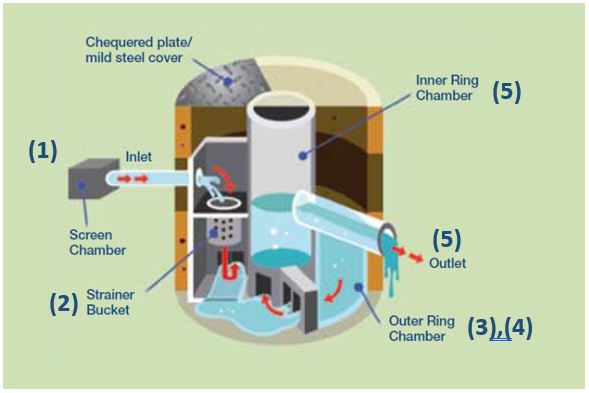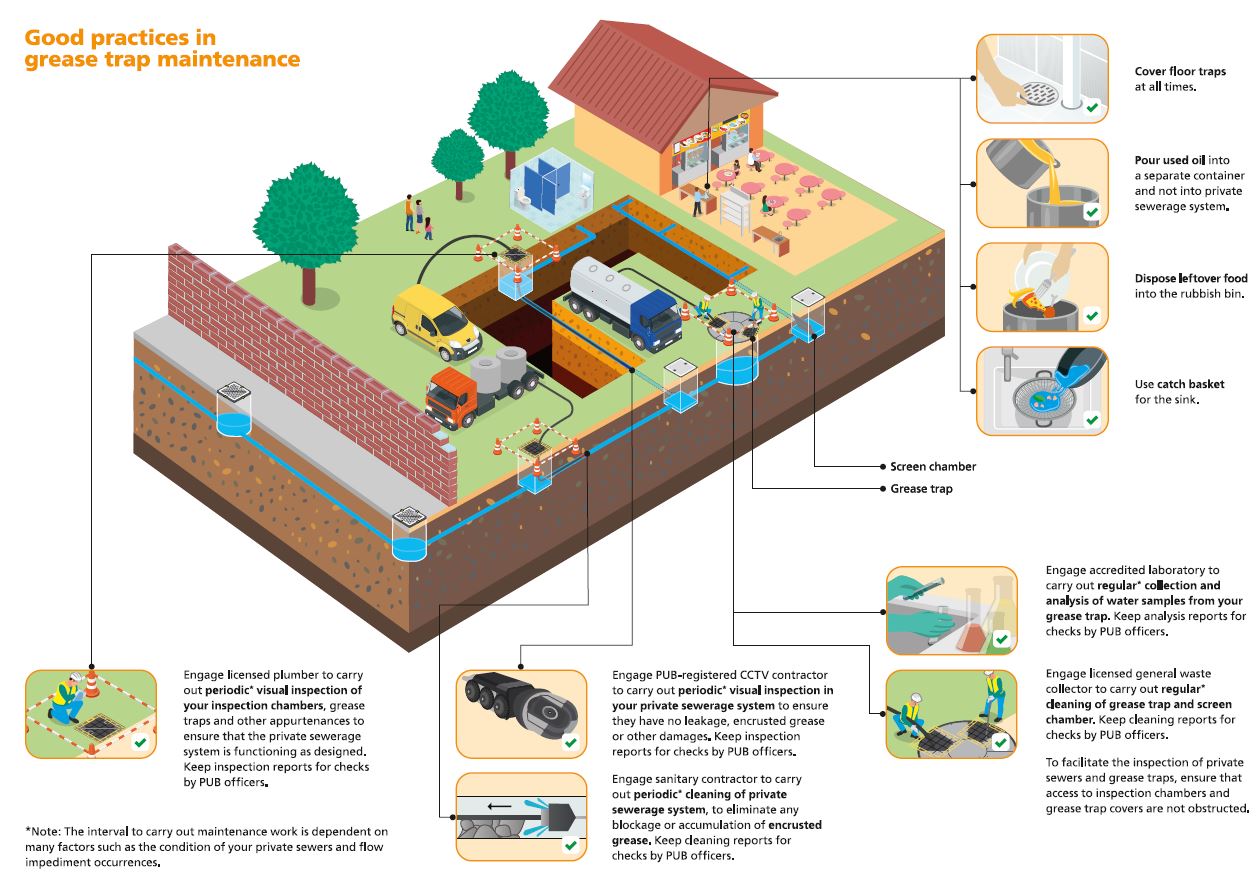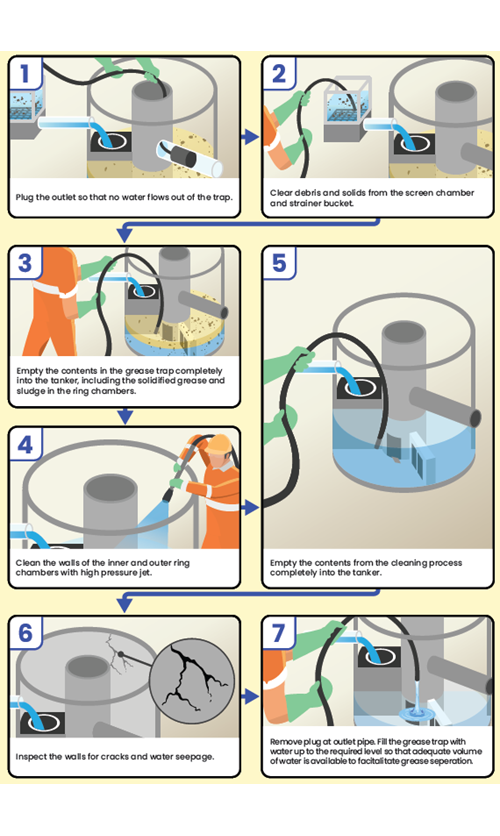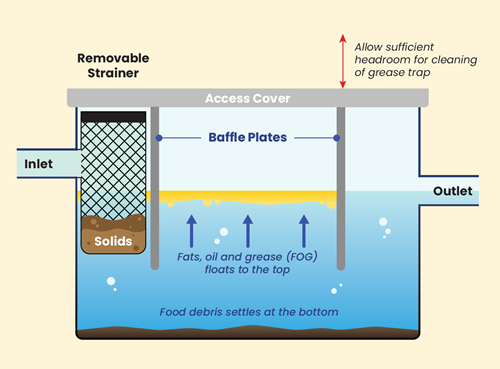A grease trap is any interceptor, arrestor, tank, or pit situated above or under the ground that allows cooling and separation of grease from used water. Fat, oil, and grease discharged from food establishments are major causes of blockages in the public sewerage system. Without a properly sized and maintained grease trap, grease will enter the sewers and accumulate. This will result in encrustation, which will obstruct the smooth flow of used water in the sewers and cause it to overflow into your premises or other public areas.
All establishments that handle food, including restaurants, coffee shops and hawker centres, require grease traps.

Step 1: Coarse solids in used water are removed when the water passes through the screen chamber.
Step 2: Smaller solids in used water are further removed at the strainer bucket.
Step 3: Less dense fat, grease, and oil in used water are separated as the water enters and circulates around the outer ring chamber.
Step 4: Denser remnant solids sink to the bottom of the outer ring.
Step 5: Used water enters the inner ring chamber where it is discharged into the sewer via the outlet pipe through water displacement.
When installing a grease trap, you should take note of the following:
a) Grease traps are used to pre-treat only culinary water from the food preparation area and kitchen. Used water discharged from toilets and other sanitary drain lines (private sewers) not serving the food preparation area shall be connected to the sewers and bypass the grease trap.
b) Grease traps are to be installed in a location that is easily accessible for maintenance works. A properly located grease trap can prevent health risks, other public health hazards.
c) Owners are required to seek NEA's and PUB's approval before installation of grease traps.
For more information on installing your grease trap, you can refer to PUB's Code of Practice on Sewerage and Sanitary Works here.

Maintaining your grease trap properly can help prevent:
a) Offensive odours
b) Flow blockage due to accumulation of oil and grease in the sewerage system
c) Overflow of used water from blocked sewers onto your premise or other public areas
Besides giving your patrons a pleasant eating environment, the measures that you put in place will also help to protect our precious water resources and address public health concerns.
Food establishments may refer to the following recommended frequencies for maintenance. The interval to carry out maintenance work is dependent on many factors such as the condition of your private sewerage system, and you may need to increase the maintenance frequencies accordingly to site-specific conditions
Download this guide to learn more about how you can maintain your grease traps.
| S/N | Maintenance Activity for Food Establishments (Hawker Centres, Eateries, Coffeeshops, including those in Malls) | Carried Out By | Recommended Frequency |
|---|---|---|---|
| 1 | Cleaning maintenance of grease traps | Licensed General Waste Collector | At least once every 2 weeks (to increase if culinary water contains a higher Fats, Oil, and Grease loading.) |
| 2 | Cleaning/flushing of private sewerage system to eliminate any blockage or accumulation of encrusted grease. |
Sanitary contractor | At least once every 6 months |
| 3 | CCTV inspection of private sewerage system for any leakage, encrusted grease, or damages. |
PUB-registered CCTV contractor |
At least once every 5 years |
| 4 | Visual inspection of inspection chambers, grease traps, and other appurtenances |
Licensed plumber |
At least once every 5 years |
There are two types of grease traps that are commonly available:
a) Standard circular grease traps, which are usually constructed underground; and
b) Portable grease interceptors, which are usually installed aboveground.
A portable grease interceptor may be installed only if the provision of a standard grease trap is not feasible due either to space constraint or to other difficulties related to the site. If installed, portable grease interceptors have to be of a size that can meet the loading capacity of the eating establishment. Its design should also allow for the easy removal of the cover for maintenance works.
In addition, a portable grease interceptor must incorporate a mechanical oil-skimming device to automatically remove free-floating grease and oil from the interceptor. You may refer to the Code of Practice on Sewerage and Sanitary Works for more details.
Grease traps shall be sized in accordance with guidelines stipulated in BS-EN1825.
Note:
i. Grease trap capacity shall be based on "nominal size" specified in BS-EN1825
ii. The maximum flow rate for selection of nominal size shall be calculated based on appliances/fittings discharging into the grease trap and typical flow rate and frequency factor in EN 1825-2
| Size of PUB's Standard Circular Grease Trap | Estimated Number of Stalls |
|---|---|
| Small Circular Grease Trap Refer to PUB's Standard Drawing PUB/WRN/STD/041 (Equivalent to Nominal Size 2 of EN-1825-1) |
6 |
| Large Circular Grease Trap Refer to PUB's Standard Drawing PUB/WRN/STD/040 (Equivalent to Nominal Size 4 of EN-1825-1) |
12 |
Illustrated for reference only – grease trap sizing is to be done in accordance with BS-EN1825.
Fat, oil, and grease discharged from eating establishments are some causes of blockages in sewers. Maintaining your grease trap properly can prevent:
a) Offensive odours
b) Flow blockage due to accumulation of oil and grease in the sewerage system
c) Overflow of used water from blocked sewers onto your premise or other public areas
Besides giving your patrons a pleasant eating environment, the measures that you put in place will also help to protect our precious water resources and address public health concerns.
Food establishments may refer to the following recommended frequencies for maintenance. The interval to carry out maintenance work is dependent on many factors such as the condition of your private sewerage system, and you may need to increase the maintenance frequencies accordingly to site-specific conditions.
| S/N | Maintenance Activity for Food Establishments (Hawker Centres, Eateries, Coffeeshops, including those in Malls) | Carried Out By | Recommended Frequency |
|---|---|---|---|
| 1 | Cleaning maintenance of grease traps | Licensed General Waste Collector | At least once every 2 weeks (to increase if culinary water contains a higher Fats, Oil, and Grease loading.) |
| 2 | Cleaning/flushing of private sewerage system to eliminate any blockage or accumulation of encrusted grease. |
Sanitary contractor | At least once every 6 months |
| 3 | CCTV inspection of private sewerage system for any leakage, encrusted grease, or damages. |
PUB-registered CCTV contractor |
At least once every 5 years |
| 4 | Visual inspection of inspection chambers, grease traps, and other appurtenances |
Licensed plumber |
At least once every 5 years |
Practise Source Control
Adopt good practices in the work area to reduce greasy waste discharge from the food preparation area into your grease trap by following these simple tips:
a) Cover floor traps at all times
b) Pour used oil into a separate container and not into private sewerage system
c) Dispose leftover food into rubbish bins
d) Use catch basket for the sink.
Establish an Inspection Schedule
Carry out regular visual checks on your private sewerage system and grease trap to ensure that they are in good physical condition and are not damaged in any way that may pose a health risk or safety hazard to the public. The recommended guidelines are as follows:
Daily Checklist
a) Check the screen chamber for accumulation of debris that may obstruct the flow of used water into the grease trap.
b) Check the strainer bucket for accumulation of debris that may affect the effective capturing of solids in the bucket.
c) Collect debris in a disposable bag and dispose of them as solid waste.
d) Check that the water in the grease trap is maintained at the required level to facilitate grease separation.
e) Check for excessive built-up of greasy waste or if the greasy waste has hardened.
f) Check that there is no greasy waste in the inner ring chamber.
You are advised to take immediate steps to repair your grease trap if you notice any damage to your grease trap, or when such damage is brought to your attention by the general waste collector or officers from the relevant authorities - PUB and the National Environment Agency (NEA).
Have a Cleaning/Maintenance Schedule
You should engage only competent person to clean your private sewerage system and grease trap. The interval to carry out maintenance work is dependent on many factors such as loading of your grease trap. As a guide, you may consider to clean your grease trap every fortnight by engaging a licenced general waste collector (Class C).
Cleaning Checklist
a) Check that the Contractor is a licensed general waste collector.
b) Supervise the Contractor to ensure that the grease trap is cleaned in accordance with the PUB’s recommended steps in cleaning grease traps.
c) Check and replace any defective or corroded covers of grease trap.
d) Check that the covers of your grease trap are properly covered after cleaning.
e) Check that the access to the inspection chambers and covers of your grease trap is kept free from obstruction.
f) Check the area surrounding the grease trap is clean and does not pose any threat to public health.
Ensuring your grease trap is cleaned regularly and adequately is your responsibility. The recommended steps for cleaning grease traps are as follows:

Your portable grease interceptor is specifically sized to handle the volume of sullage water produced by your culinary activities. If your culinary activity has increased, you may need to increase the capacity of your portable grease interceptor. Always consult a Qualified Person to ensure your portable grease interceptor is properly sized to meet your needs. As portable grease interceptors vary by the different manufacturers, consult your Qualified Person for the maintenance requirements for your particular type of portable grease interceptor.
You can implement the following recommended inspection and maintenance regime to properly maintain your grease interceptor, if there are no recommended procedures by the manufacturer:

a) Ensure no culinary used water is discharged and no running water is used during maintenance of the grease interceptor.
b) Inspect the strainer bucket in the grease interceptor and clear any debris build-up.
c) Remove the floating fats, oil and grease from the water surface and debris from the bottom of the interceptor using a shovel or heavy-duty scooper. Dispose of these in a trash bag.
d) Drain the water from the grease interceptor using a bucket or small pump.
e) Scrape residues from all surfaces of the grease interceptor, including sides, baffles, lid and bottom. Rinse the strainer. Use an absorbent pad to clean the surfaces of interceptor and the strainer, disposing of soiled pads in the trash bag.
f) Securely tie the trash bag to prevent leakage and dispose of it appropriately in a designated receptacle.
STEP 1: You need to check that your contractor is carrying out the cleaning task in accordance to PUB’s recommended steps for cleaning grease traps.
STEP 2: If you are already cleaning your grease trap on a fortnightly basis in accordance to PUB’s recommended steps for cleaning grease traps, and are still unable to meet the discharge limits, your grease trap may be inadequate to cater to the volume of used water generated by your eatery.
a) Grease traps should be sized in accordance to the amount of culinary water to be treated, and designed to allow for maximum oil-and-water separation efficiency by taking into account factors such as the temperature and velocity of used water entering the grease trap.
b) You may consider installing more grease traps in your premises to cope with any increase in the volume of culinary water to be treated. You may consult qualified persons such as registered professional engineers, plumbers, or grease traps’ suppliers to assist you in your consideration.
c) You may submit your application online at the PUB website if you wish to install additional grease trap(s) in your premises.
The management of greasy waste including its collection and disposal is governed by the Environmental Public Health Act (EPHA), which is administered by the National Environment Agency (NEA). The Code of Practice for Licensed General Waste Collectors specifies the roles and responsibilities of licensed general waste collectors. It also provides guidelines on good practices in the waste collection business. Licensed general waste collectors are expected to adhere to these guidelines so as to improve the standard of their operations and raise the professionalism of service rendered.
If you have any issues or complaints regarding your licensed waste collector, you may refer the matter to NEA at 1800-2255 6321800-2255 632 or email to Contact_NEA@nea.gov.sg.
You may visit the following websites for more information:

Alternatively, to speak to PUB on the maintenance of your private sewerage system including Grease Traps, please contact: PUB-ONE (24-hour toll-free hotline): 1800-2255-7821800-2255-782
There are two types of grease traps that are commonly available:
a) Standard circular grease traps, which are usually constructed underground; and
b) Portable grease interceptors, which are usually installed aboveground.
A portable grease interceptor may be installed only if the provision of a standard grease trap is not feasible due either to space constraint or to other difficulties related to the site. If installed, portable grease interceptors have to be of a size that can meet the loading capacity of the eating establishment. Its design should also allow for the easy removal of the cover for maintenance works.
In addition, a portable grease interceptor must incorporate a mechanical oil-skimming device to automatically remove free-floating grease and oil from the interceptor. You may refer to the Code of Practice on Sewerage and Sanitary Works for more details.
Grease traps shall be sized in accordance with guidelines stipulated in BS-EN1825.
Note:
i. Grease trap capacity shall be based on "nominal size" specified in BS-EN1825
ii. The maximum flow rate for selection of nominal size shall be calculated based on appliances/fittings discharging into the grease trap and typical flow rate and frequency factor in EN 1825-2
| Size of PUB's Standard Circular Grease Trap | Estimated Number of Stalls |
|---|---|
| Small Circular Grease Trap Refer to PUB's Standard Drawing PUB/WRN/STD/041 (Equivalent to Nominal Size 2 of EN-1825-1) |
6 |
| Large Circular Grease Trap Refer to PUB's Standard Drawing PUB/WRN/STD/040 (Equivalent to Nominal Size 4 of EN-1825-1) |
12 |
Illustrated for reference only – grease trap sizing is to be done in accordance with BS-EN1825.
Fat, oil, and grease discharged from eating establishments are some causes of blockages in sewers. Maintaining your grease trap properly can prevent:
a) Offensive odours
b) Flow blockage due to accumulation of oil and grease in the sewerage system
c) Overflow of used water from blocked sewers onto your premise or other public areas
Besides giving your patrons a pleasant eating environment, the measures that you put in place will also help to protect our precious water resources and address public health concerns.
Food establishments may refer to the following recommended frequencies for maintenance. The interval to carry out maintenance work is dependent on many factors such as the condition of your private sewerage system, and you may need to increase the maintenance frequencies accordingly to site-specific conditions.
| S/N | Maintenance Activity for Food Establishments (Hawker Centres, Eateries, Coffeeshops, including those in Malls) | Carried Out By | Recommended Frequency |
|---|---|---|---|
| 1 | Cleaning maintenance of grease traps | Licensed General Waste Collector | At least once every 2 weeks (to increase if culinary water contains a higher Fats, Oil, and Grease loading.) |
| 2 | Cleaning/flushing of private sewerage system to eliminate any blockage or accumulation of encrusted grease. |
Sanitary contractor | At least once every 6 months |
| 3 | CCTV inspection of private sewerage system for any leakage, encrusted grease, or damages. |
PUB-registered CCTV contractor |
At least once every 5 years |
| 4 | Visual inspection of inspection chambers, grease traps, and other appurtenances |
Licensed plumber |
At least once every 5 years |
Practise Source Control
Adopt good practices in the work area to reduce greasy waste discharge from the food preparation area into your grease trap by following these simple tips:
a) Cover floor traps at all times
b) Pour used oil into a separate container and not into private sewerage system
c) Dispose leftover food into rubbish bins
d) Use catch basket for the sink.
Establish an Inspection Schedule
Carry out regular visual checks on your private sewerage system and grease trap to ensure that they are in good physical condition and are not damaged in any way that may pose a health risk or safety hazard to the public. The recommended guidelines are as follows:
Daily Checklist
a) Check the screen chamber for accumulation of debris that may obstruct the flow of used water into the grease trap.
b) Check the strainer bucket for accumulation of debris that may affect the effective capturing of solids in the bucket.
c) Collect debris in a disposable bag and dispose of them as solid waste.
d) Check that the water in the grease trap is maintained at the required level to facilitate grease separation.
e) Check for excessive built-up of greasy waste or if the greasy waste has hardened.
f) Check that there is no greasy waste in the inner ring chamber.
You are advised to take immediate steps to repair your grease trap if you notice any damage to your grease trap, or when such damage is brought to your attention by the general waste collector or officers from the relevant authorities - PUB and the National Environment Agency (NEA).
Have a Cleaning/Maintenance Schedule
You should engage only competent person to clean your private sewerage system and grease trap. The interval to carry out maintenance work is dependent on many factors such as loading of your grease trap. As a guide, you may consider to clean your grease trap every fortnight by engaging a licenced general waste collector (Class C).
Cleaning Checklist
a) Check that the Contractor is a licensed general waste collector.
b) Supervise the Contractor to ensure that the grease trap is cleaned in accordance with the PUB’s recommended steps in cleaning grease traps.
c) Check and replace any defective or corroded covers of grease trap.
d) Check that the covers of your grease trap are properly covered after cleaning.
e) Check that the access to the inspection chambers and covers of your grease trap is kept free from obstruction.
f) Check the area surrounding the grease trap is clean and does not pose any threat to public health.
Ensuring your grease trap is cleaned regularly and adequately is your responsibility. The recommended steps for cleaning grease traps are as follows:

Your portable grease interceptor is specifically sized to handle the volume of sullage water produced by your culinary activities. If your culinary activity has increased, you may need to increase the capacity of your portable grease interceptor. Always consult a Qualified Person to ensure your portable grease interceptor is properly sized to meet your needs. As portable grease interceptors vary by the different manufacturers, consult your Qualified Person for the maintenance requirements for your particular type of portable grease interceptor.
You can implement the following recommended inspection and maintenance regime to properly maintain your grease interceptor, if there are no recommended procedures by the manufacturer:

a) Ensure no culinary used water is discharged and no running water is used during maintenance of the grease interceptor.
b) Inspect the strainer bucket in the grease interceptor and clear any debris build-up.
c) Remove the floating fats, oil and grease from the water surface and debris from the bottom of the interceptor using a shovel or heavy-duty scooper. Dispose of these in a trash bag.
d) Drain the water from the grease interceptor using a bucket or small pump.
e) Scrape residues from all surfaces of the grease interceptor, including sides, baffles, lid and bottom. Rinse the strainer. Use an absorbent pad to clean the surfaces of interceptor and the strainer, disposing of soiled pads in the trash bag.
f) Securely tie the trash bag to prevent leakage and dispose of it appropriately in a designated receptacle.
STEP 1: You need to check that your contractor is carrying out the cleaning task in accordance to PUB’s recommended steps for cleaning grease traps.
STEP 2: If you are already cleaning your grease trap on a fortnightly basis in accordance to PUB’s recommended steps for cleaning grease traps, and are still unable to meet the discharge limits, your grease trap may be inadequate to cater to the volume of used water generated by your eatery.
a) Grease traps should be sized in accordance to the amount of culinary water to be treated, and designed to allow for maximum oil-and-water separation efficiency by taking into account factors such as the temperature and velocity of used water entering the grease trap.
b) You may consider installing more grease traps in your premises to cope with any increase in the volume of culinary water to be treated. You may consult qualified persons such as registered professional engineers, plumbers, or grease traps’ suppliers to assist you in your consideration.
c) You may submit your application online at the PUB website if you wish to install additional grease trap(s) in your premises.
The management of greasy waste including its collection and disposal is governed by the Environmental Public Health Act (EPHA), which is administered by the National Environment Agency (NEA). The Code of Practice for Licensed General Waste Collectors specifies the roles and responsibilities of licensed general waste collectors. It also provides guidelines on good practices in the waste collection business. Licensed general waste collectors are expected to adhere to these guidelines so as to improve the standard of their operations and raise the professionalism of service rendered.
If you have any issues or complaints regarding your licensed waste collector, you may refer the matter to NEA at 1800-2255 6321800-2255 632 or email to Contact_NEA@nea.gov.sg.
You may visit the following websites for more information:

Alternatively, to speak to PUB on the maintenance of your private sewerage system including Grease Traps, please contact: PUB-ONE (24-hour toll-free hotline): 1800-2255-7821800-2255-782